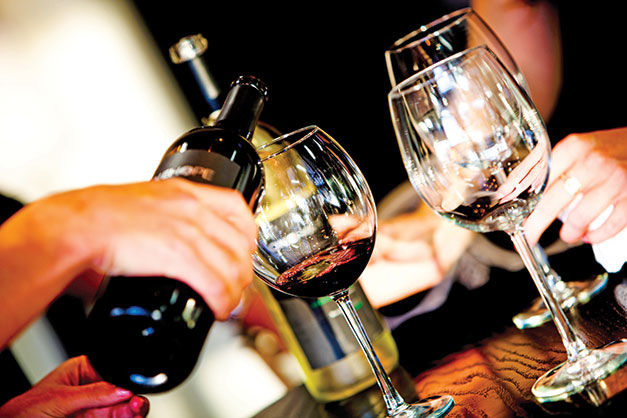Tasting wine is probably the most important part of enjoying wine. Unfortunately, too many people think wine tasting is either beyond their grasp or a holier-than-thou form of wine snobbery. While there may be a correct way to taste wine, how you taste it is up to you.
Many people have seen 100-point rating scales in various publications and some are old enough to remember the 20-point rating scale from the University of California Davis that preceded the higher point scale. Some think of wine as good-versus-bad, yummy, tasty, or just give-me-another-glass, assuming it must be good because it has alcohol.

FINE wines in San Diego
The first tip for tasting wine is to be adventurous; experiment and taste wines you’ve never had before. Then the analysis begins. There is a step-by-step process by which to taste wine—or so the sommeliers will tell you. David Glancy, a Master Sommelier and founder of the San Francisco Wine School, offered some advice: "The four main families of taste are sweet, sour, salty and bitter, and since salt is not generally found in wine, that leaves three primary tastes."

Wine Tasting
Eddie Osterland—the first Master Sommelier in the United States, a resident of San Diego and author of "Power Entertaining"—described the beginning of wine analysis using the same three essential components as Gancy. Osterland characterized the three components that influence wine’s taste as "sweetness (from sugar and alcohol), sourness (from acidity) and bitterness (from tannins)." Most everyone understands the concepts of sweetness, sourness and bitterness, so this sentence is helpful in understanding these components of wine.
Some people can discern the components and their impact right away. Others learn to find them in the wine, identify them and then complete their analysis of wine. Consider it a learning process or as a training of the palate. You need to use your taste buds, which Osterland describes as "distinctly different as your fingerprints."

San Diego Wine makers
"For this reason the taster needs to go with their gut (trust their own palate) and not necessarily rely on some wine critic’s 91/100 score," he said. "No one tastes the same wine exactly the same and developing your own skill is what everyone needs to do."
So how do you do that? There are essentially five steps to tasting wine. Begin by looking at the shade of color and the opacity of the wine. To get started, pour three different white wines into glasses and look at them. Then do the same with three different red wines. How do they compare with one another? Darker? More intense? Is one more difficult to see through? Think of their colors—does one look pale yellow or a rich golden color? In the case of red wine, is there a color variation at the rim when you hold the glass near horizontal to spread the wine and its color? There are color charts that you can look at to begin to understand the color variations that you may experience and what they tell you about the wine. For example, a browning of the red color at the edges indicates an older wine.

Terroir wine tasting
After you learn from the appearance of the wine, you move on to its smell. You may have heard someone describe a white wine as having citrus on the nose, the smell of a rotten egg, or the smell of pineapple. In the case of red wine, you may have heard the description of red berries, floral of lavender, or cedar. Each of these smells and those depicted on an aroma wheel can help you to discern the type of wine. In some cases, they can help you to learn if the wine is "New World" or "Old World." The more that the wine is swirled in the glass, the better to smell the wine and discern the nuances of the aromas.
The next component is to taste the wine. Everyone loves this step. Take a small sip (not a gulp, and don’t swallow yet). Briefly swish the wine around your mouth to coat your tongue and your mouth before swallowing. As you swirl it—also before and after swallowing the wine—think about the flavors, textures and body of the wine. Is the wine thin or is it opaque? Is it unctuous? Do the flavors match the smells from the aromas detected before tasting? Does the wine result in the burning sensation of alcohol? Does the wine have a bitter taste from the tannins? How long is the finish? Space does not allow us to get into consideration of swallowing or spitting, so just taste and enjoy.

Women and wine
Now, think about what you have tasted. The first question to ask is whether you liked it. If so, why? Do you want to drink it again? If the answer is no, try to determine what you did not like about the wine.
When possible, participate in a tasting with others. After tasting and exploring your feelings about a wine, discuss others’ perceptions. This can be great fun. The bottom line is to find wines that suit your palate and enjoy them. If you want to take your wine tasting to another level, see the documentary "Somm" or enroll in a wine tasting class—and then start tasting!









(0) comments
We welcome your comments
Log In
Post a comment as Guest
Keep it Clean. Please avoid obscene, vulgar, lewd, racist or sexually-oriented language.
PLEASE TURN OFF YOUR CAPS LOCK.
Don't Threaten. Threats of harming another person will not be tolerated.
Be Truthful. Don't knowingly lie about anyone or anything.
Be Nice. No racism, sexism or any sort of -ism that is degrading to another person.
Be Proactive. Use the 'Report' link on each comment to let us know of abusive posts.
Share with Us. We'd love to hear eyewitness accounts, the history behind an article.